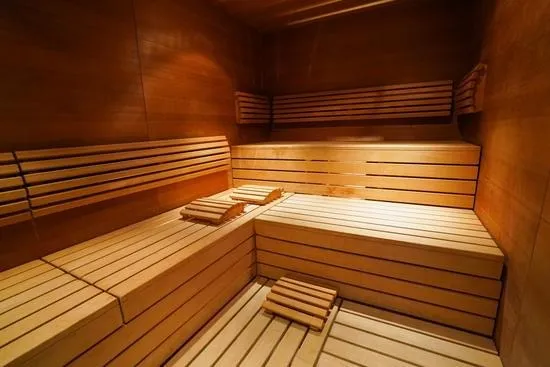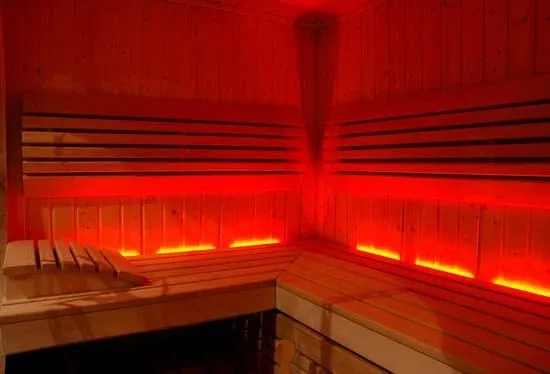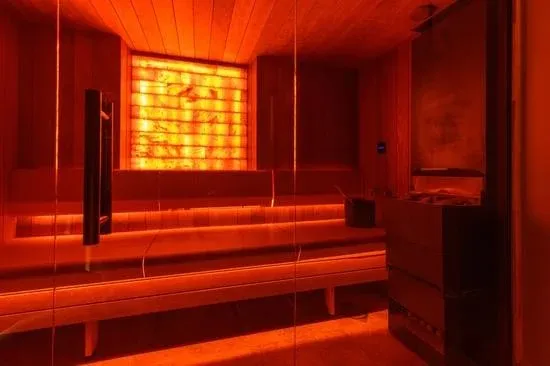When I first heard about infrared saunas, I'll be honest—I was skeptical. How could something operating at 130°F deliver the same benefits as a traditional sauna cranked to 180°F? It didn't make sense. Until I actually tried one.
That experience changed everything. Within 15 minutes, I was sweating just as profusely as I would in a traditional sauna, but without that overwhelming, can't-breathe sensation. My wife Jasmin, who had always struggled with the intense heat of traditional saunas, finally found a sauna she could actually enjoy and use consistently.
Now, eight years into our family's wellness journey, infrared technology has become a cornerstone of how we maintain our health. Let me share what I've learned about why these modern marvels are changing the home wellness game.
Understanding Infrared Technology
Here's the science without the jargon: Traditional saunas heat the air, and that hot air heats you. Infrared saunas skip the middleman. They use infrared light waves—the same wavelengths the sun produces (but without the harmful UV rays)—to heat your body directly.
Think of it like the difference between an oven and a microwave. An oven heats the air around your food, which then heats the food. A microwave directly heats the water molecules in the food itself. Infrared saunas work more like that microwave principle, penetrating up to 1.5 inches into your tissues.
The result? You get deep, penetrating heat at much lower ambient temperatures. This isn't just a more comfortable experience—it actually offers unique therapeutic benefits.
The Three Types of Infrared
Not all infrared is created equal. There are actually three types, each with different wavelengths and benefits:
Near-Infrared (NIR)
Wavelength: 0.7-1.4 microns
Penetration: Skin surface to ~1mm deep
Benefits:
- Promotes skin health and wound healing
- Stimulates collagen production
- Reduces inflammation at the cellular level
- Supports mitochondrial function
Mid-Infrared (MIR)
Wavelength: 1.4-3 microns
Penetration: Deeper into soft tissues
Benefits:
- Improves circulation and cardiovascular function
- Promotes muscle recovery
- Supports immune response
- Enhances oxygen delivery to tissues
Far-Infrared (FIR)
Wavelength: 3-100 microns
Penetration: Deepest (up to 1.5 inches)
Benefits:
- Most effective for detoxification through sweating
- Deepest pain relief for joints and muscles
- Strongest cardiovascular conditioning effects
- Best for weight management and metabolic benefits
Most quality home infrared saunas use far-infrared or full-spectrum technology (combining all three types). We opted for full-spectrum at home because why choose when you can have all the benefits?

How Infrared Differs from Traditional Saunas
Let's get practical. Here's what you'll actually notice:
| Aspect | Traditional Sauna | Infrared Sauna |
|---|---|---|
| Operating Temperature | 150-195°F | 120-140°F |
| Warm-up Time | 30-45 minutes | 10-15 minutes |
| Heat Type | Convection (air heating) | Radiation (direct body heating) |
| Sweat Composition | 97% water, 3% toxins | 80-85% water, 15-20% toxins |
| Energy Efficiency | Higher consumption | Lower consumption |
| Installation | Usually professional required | Often DIY-friendly |
That sweat composition difference is particularly interesting. Research from Dr. David E. Bank shows that infrared saunas promote a more efficient detoxification response because the deeper tissue penetration mobilizes toxins stored in fat cells.
The Science-Backed Health Benefits
Okay, enough theory. What will an infrared sauna actually do for you? Here's what the research shows:
Cardiovascular Health
A 2020 study in the Journal of Human Hypertension found that regular infrared sauna use significantly improved vascular function and reduced blood pressure. Your heart rate increases to 100-150 beats per minute during a session—similar to moderate cardiovascular exercise—without the joint stress.
For people with heart conditions (always consult your doctor first), this can be a game-changer. It's like getting a cardiovascular workout while sitting still.
Pain Relief and Recovery
This is where infrared really shines. The deep tissue penetration provides relief for:
- Chronic pain conditions (arthritis, fibromyalgia)
- Sports injuries and muscle soreness
- Joint stiffness and inflammation
- Back pain and sciatica
According to research from the University of Toyama, patients with chronic pain experienced significant improvements after just 10 infrared sauna sessions over two weeks.
Detoxification
We're exposed to environmental toxins daily—heavy metals, BPA, pesticides, the list goes on. Infrared saunas help your body eliminate these through enhanced sweating. Studies show increased excretion of:
- Heavy metals (mercury, lead, cadmium)
- BPA and plasticizers
- Pesticides and herbicides
- Environmental pollutants
This was particularly important for our family. When we changed our approach to health, we wanted every tool possible to help our bodies function optimally. Regular detoxification through infrared sauna sessions became part of that toolkit.
Skin Health
Here's a vanity benefit I didn't expect: my skin looks noticeably better after consistent sauna use. The improved circulation brings nutrients to your skin, while sweating clears pores. Research shows infrared therapy can:
- Reduce wrinkles and improve skin tone
- Accelerate wound healing
- Reduce acne and clear complexion
- Improve overall skin texture and elasticity
Jasmin swears by her post-sauna glow. She says it's better than any facial.
Weight Management and Metabolic Health
While no sauna replaces proper diet and exercise, infrared sessions can support weight management. A 30-minute session can burn 300-600 calories as your body works to cool itself. More importantly, infrared therapy:
- Improves insulin sensitivity
- Supports metabolic function
- Reduces inflammation associated with obesity
- Helps regulate appetite hormones
Who Should Consider an Infrared Sauna?
Based on my experience helping people at Ease Wellness, infrared saunas are particularly beneficial for:
Heat-Sensitive Individuals: If you've tried traditional saunas and felt claustrophobic or couldn't breathe comfortably, infrared's lower temperatures make a huge difference.
Chronic Pain Sufferers: The deep tissue penetration provides relief that surface heat can't match. Many of our clients with fibromyalgia or arthritis prefer infrared specifically for this reason.
People with Busy Schedules: That quick 10-15 minute warm-up means you can use it more spontaneously. No need to plan an hour ahead.
First-Time Sauna Buyers: Infrared units are often more affordable, easier to install, and simpler to maintain than traditional saunas. It's a lower-barrier entry point to sauna therapy.
Energy-Conscious Users: The lower operating temperatures and quick warm-up mean less electricity consumption—better for your wallet and the planet.
Apartment Dwellers: Many innovative designs manufacturers are developing plug into standard outlets and don't require permanent installation.
Choosing the Right Infrared Sauna
If you're sold on infrared technology, here's what to look for:
Heater Type
Carbon Fiber Heaters: Larger surface area, more even heat distribution, longer lifespan. These are my top recommendation.
Ceramic Heaters: Heat up faster, reach higher temperatures, more focused heat. Good but can have hot spots.
Full-Spectrum Heaters: Combine all three infrared wavelengths. Most comprehensive benefits but typically more expensive.
Wood Quality
Just like traditional saunas, wood matters:
- Cedar: Naturally antimicrobial, beautiful aroma, most popular
- Basswood: Hypoallergenic, no scent, stays cooler to touch
- Hemlock: Light color, budget-friendly, minimal odor
Size and Configuration
Think about:
- How many people will use it simultaneously?
- Do you want to lie down or just sit?
- What's your available space?
- Do you need it to be portable?
EMF Levels
This is important. Look for low-EMF or ultra-low-EMF ratings. You're spending 20-40 minutes close to those heaters—EMF exposure matters. Quality manufacturers will provide specific EMF testing data.
Warranty
A good infrared sauna should have:
- Lifetime warranty on heaters (or at least 10+ years)
- 5-10 year warranty on structural components
- 1-3 year warranty on electrical components
Common Misconceptions
Let me clear up some confusion I hear all the time:
"Infrared saunas aren't 'real' saunas."
Wrong. They're just different. Both provide heat therapy benefits. The delivery method differs, but the physiological responses are equally valid.
"You need higher heat to get real benefits." Actually, the deeper tissue penetration at lower temperatures can provide more targeted benefits for certain conditions. It's not about heat intensity—it's about effective delivery.
"Infrared radiation is dangerous." Infrared is non-ionizing radiation—completely different from harmful UV or X-rays. It's the same type of heat you feel from the sun on a mild day, minus the UV damage.
"They're just a fad." Infrared therapy has been studied extensively since the 1960s. NASA used it for astronaut health. It's been mainstream in medical settings for decades. For home wellness, it's relatively new, but the science is well-established.
Practical Tips for Your First Sessions
When you get your infrared sauna, start smart:
Session 1-3: 10-15 minutes at 120-130°F. Get used to the sensation.
Session 4-10: 15-25 minutes at 130-140°F. Find your comfort zone.
Ongoing: 20-40 minutes at your preferred temperature, 3-4 times weekly.
Always:
- Hydrate before and after
- Bring a towel to sit on and wipe sweat
- Listen to your body—exit if you feel dizzy
- Shower after to rinse away toxins
- Replace electrolytes if you sweat heavily
The Bottom Line
Infrared saunas aren't replacing traditional saunas—they're expanding what sauna therapy can be. They make the profound health benefits of heat therapy accessible to more people, in more situations, with greater convenience.
For our family, infrared technology removed the barriers that kept us from consistent sauna use. Lower temperatures meant Jasmin could join me. Quick warm-up meant we could fit sessions into busy days. The specific benefits for pain relief and detoxification aligned perfectly with our wellness goals.
Whether infrared is right for you depends on your priorities. But if you've been on the fence about home sauna therapy, infrared technology might be exactly what makes it practical and sustainable for your lifestyle.
The ancient practice of heat therapy has met modern technology, and the results are pretty remarkable. Your body doesn't care whether the heat comes from hot rocks or infrared panels—it responds to the therapeutic stimulus either way. The question is: which delivery method works best for your life?
FAQs About Infrared Saunas
Yes, but in different ways. Infrared saunas operate at lower temperatures but penetrate tissues more deeply. Studies show similar cardiovascular benefits, with some research suggesting better results for pain relief and detoxification. The choice depends on your heat tolerance and specific health goals.
Full-spectrum infrared (combining all three) offers the most comprehensive benefits. Near-infrared supports skin health and wound healing. Mid-infrared improves circulation. Far-infrared penetrates deepest for detoxification and pain relief. Most quality home saunas use far-infrared or full-spectrum technology.
Most infrared saunas reach operating temperature in 10-15 minutes, compared to 30-45 minutes for traditional saunas. This quick warm-up time makes infrared saunas more convenient for daily use and more energy-efficient overall.
References
- Bank DE. "Infrared Sauna Therapy for Detoxification." Alternative Therapies in Health and Medicine, 2012.
- Miyata M, Tei C. "Waon Therapy Improves Vascular Function." Journal of Human Hypertension, 2020.
- Masuda A, et al. "The effects of repeated thermal therapy for patients with chronic pain." University of Toyama, 2005.
- Crinnion WJ. "Sauna as a valuable clinical tool for cardiovascular, autoimmune, toxicant-induced and other chronic health problems." Alternative Medicine Review, 2011.





